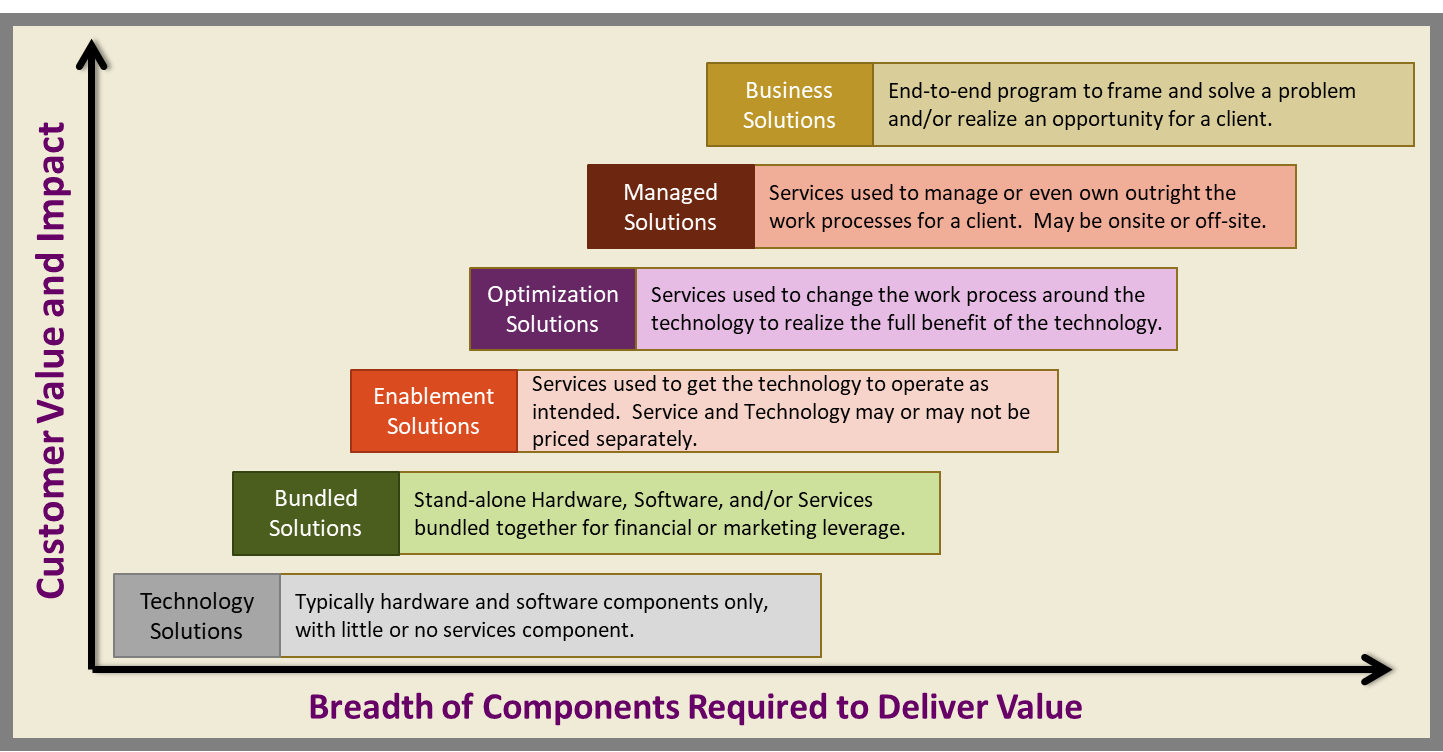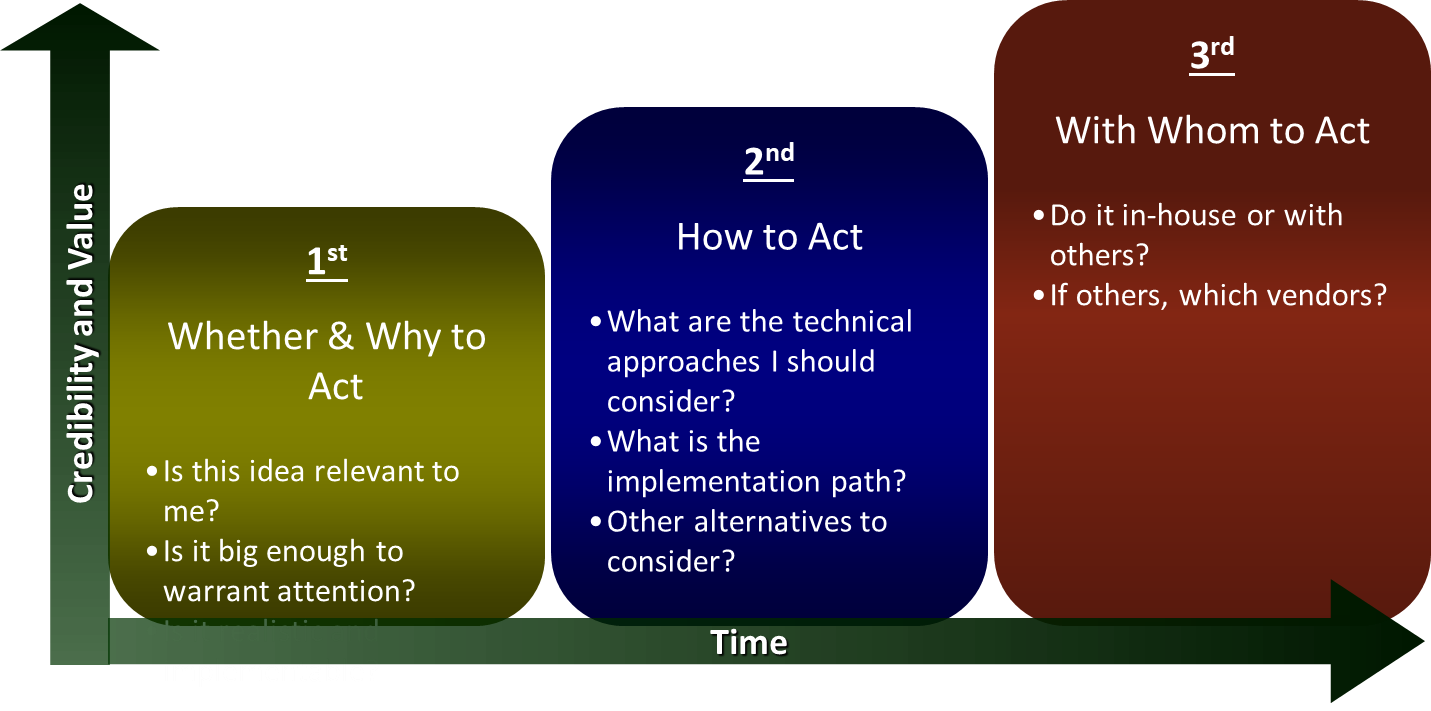One of the first steps in becoming an outcomes-based Professional Service (PS) business is to have at least one outcomes-based offer that drives customer change and results. These offers can range from enhancing the use of a product to a higher-level business outcome – lower costs, improved market presence, revenue increase, or improved customer penetration. There is a natural hierarchy of solutions:

It is often difficult to move immediately to the top right and achieve the highest impact outcomes right away. It is a gradual process, but eventually, the most valuable PS businesses perform at the top level.
However, it is important to start with an offer that you feel comfortable the organization can perform. It is also important that there is customer demand for the offer. Too often we see PS groups select something they want to do and have the capabilities to do that is of little value to the customer. These offers never materialize as meaningful because few customers will buy them. Additionally, the offer must be something that your channel (sales organization etc. can and will sell). This blog is not focused on enabling the sales organization to sell outcomes-based offers – but there is real work required for that capability to be created. Not to mention, sales must be motivated to sell therefore, they must understand the compensation benefits or have line of sight to bigger deals.
A couple of important considerations for the selecting and creating an outcomes-based offer include:
Deals: These offers position the business higher in the buyer’s organization. We use the Line-of -SafetySM, the line that divides those senior executives who set budgets and direction for a client from those that manage to a budget they are given, as a tool for thinking about this.

An ideal outcomes-based offer allows the buyer to hold conversations that place them above the Line-of-SafetySM. This changes the relationship between your organization and the buyer’s organization. No longer are you a product vendor (fighting through technical buyers and procurement). Working above the Line-of-Safety provides a mechanism for going directly to the people who can act outside of budgeting cycles and create situations that matter to the buyer organization. This does not mean that the offer has to be overly large and expensive; rather, the offer just needs to meet the needs of one or more of the executives that work above the line. Further, it allows the leverage of those relationships to pull-through products or larger deals for your company, either directly or through the halo-effect.SM Again, you must choose things you can do, that buyers will buy, and that sales can sell. This new process may involve people who are not normally dealt with in your company’s normal sales process, therefore sales enablement and motivation become important.
Offer Structure: Another important aspect of a high-quality outcomes-based offer is the offer structure. Many companies sell into demand and do not create demand. A good outcomes-based offer creates demand and meets buyers where they are – intersecting them at the stage of the “whether to act” on an idea.

The offer should create conversations that have not already moved to the “With Whom to Act” stage. Once an idea has progressed to that stage, much of the value has already been extracted from the process. Also, your ability to impact the direction of the buying cycle has dissipated, and the executive team is usually no longer involved. The “Whether to Act” stage is very powerful. It can help place you above the Line-of-SafetySM and will arm your sales organization with provocative conversations.
Identifying these offers may not be as difficult as it first sounds – you know more than you think. You have expertise around why people need your products and the impact they can make. Focus on the underlying business issues that your customers have – then put the offer and related messaging into their language: what do they need to know, understand, and act upon to focus on the business benefits that making a change to their business will provide?
Once you have the proper area determined, build a Service ChainSM structured offer. This will assure that you are meeting the buyers where they are and taking them on the “Whether to Act” and “How to Act” journey. We will explore Service ChainsSM in more detail in a later blog.

In summary, use these tools as guides in identifying and building a meaningful outcome offer.
Written by: Dean McMann
About the Author: Dean McMann is a Founding Partner at McMann & Ransford with 35+ years of experience in consulting and professional services. He is a sought-after expert and speaker on topics of: B2B differentiation, professional services best practices, and overcoming commoditization. In addition to his extensive experience in the Professional Services space, Dean also serves on the board of various non-profit organizations.
